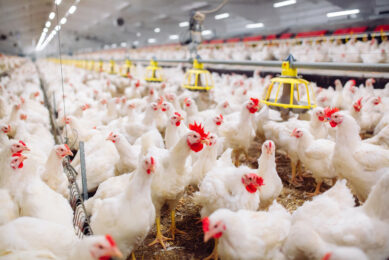Managing the intestinal carriage of APEC

Avian colibacillosis ranks as one of the most commonly encountered bacterial diseases in poultry worldwide and leads to considerable economic losses. Therefore, Wisium is investigating solutions to reduce APEC intestinal carriage.
Avian colibacillosis, an exclusively extra-intestinal disease is caused by a subgroup of pathogenic E. coli called Avian Pathogenic E. coli (APEC). APEC strains possess a variety of virulence factors that confer them the ability to survive and proliferate in the host outside of the gut environment where they normally reside.
Being the main reservoir of APEC, the gastrointestinal tract of birds and resulting excreta play a critical role in APEC propagation. A common route of infection is inhalation of the faecally contaminated dust that contains large numbers of pathogenic E. coli. Infections by APEC typically result in severe respiratory and systemic diseases such as airsacculitis and septicaemia or cause inflammation of internal organ membranes such as peritonitis, perihepatitis and pericarditis. They are also a threat to food security and avian welfare worldwide. Intensification of poultry production will increase the incidence of APEC through greater exposure of birds to pathogens and stress.
Combating economic losses
Due to the versatility of the pathogeny of avian colibacillosis, APEC can be responsible for considerable economic losses affecting multi-species and multi-physiological stage poultry farming systems, while the regulatory environment is progressively further restricting the use of antibiotics in livestock animal in efforts to halt the spreading of bacterial resistance. In the field, the consequences of APEC infection for young broilers leads mainly to mortality.
Reducing APEC intestinal carriage and faecal excretion could therefore contribute to the management of avian colibacillosis. In this context, the Wisium research and development (R&D) team is looking to evaluate the effect of a patented Copper-exchanged Clay (CeC) on APEC faecal excretion of chickens. The company has been working for almost 15 years to develop CeC, a patented nutritional specialty aiming at securing digestive process, based on an ion activated clay bringing to the product high antimicrobial potency on various pathogens. Its specificity is to act as a microflora modulator in the gut and to help monogastric animals face challenging periods. CeC is backed up by scientific evidence: more than 60 trials are available which were run both in R&D and field conditions.
French trial results
A study was carried out at INRA’s experimental infectiology platform in France, using 22 day old chicks Leghorn PA 12. The birds were orally inoculated with a highly pathogenic APEC O2 strain. Faecal bacterial counts, growth and mortality of animals supplemented with CeC were compared to an untreated group (UG).
Bacterial counts
Bacterial counts of total E. coli and APEC in faeces were performed in order to evaluate the colonisation in the gut. The inoculated APEC strain showed good gut colonisation abilities. It represented the majority of chickens E. coli flora until day 14 (100-78%). Diversification with non-pathogenic E. coli mostly occurred after day 14. CeC did not significantly alter APEC counts compared to control before day 14. However, CeC significantly reduced APEC count at day 19 (P<0.05) (>Table 1). The reduction trend was maintained numerically at day 21 (Table 2).
Growth
Growth results and survival rate were also measured. CeC supplementation did not significantly alter body weight (BW) compared to UG (Table 3).
Mortality
Clinical cases of colibacillosis were obtained and confirmed at autopsy (pericardidis). Overall mortality rate was 18%. Mortality was not significantly different between treatments but results in CeC group are encouraging with only one animal dead at day one instead of 3 in the UG (Figure 1).
Figure 1 – Survival of Leghorn chickens after inoculation.

A promising solution
Results of the monitoring of APEC excretion in faeces, combined with chicken survival and growth suggest that copper exchanged clay is an effective solution in this study to reduce APEC intestinal carriage of inoculated birds. A positive effect was obtained after E. coli flora diversified. This preliminary work is encouraging and further studies are needed to confirm these results, especially on conventional poultry strains.
Author: Pauline Pourtau, Wisium Business Developer











